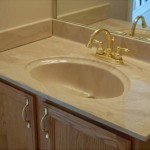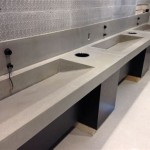Elevating Small Bathrooms with a Blue Vanity
Small bathrooms often present particular design challenges. Maximizing space while maintaining functionality and aesthetic appeal requires careful planning and strategic choices. A blue vanity can serve as a focal point, adding personality and visual interest to an otherwise compact area. This article will explore the benefits of incorporating a blue vanity into a small bathroom design, considering various styles, color palettes, and spatial optimization strategies.
The selection of a vanity is a crucial decision in any bathroom renovation project. In a small bathroom, this decision is even more critical. The vanity not only provides essential storage and a surface for daily tasks but also significantly influences the overall look and feel of the room. A blue vanity, in particular, can create a calming and refreshing atmosphere, offering a welcome contrast to the often-clinical environment of a bathroom.
The Psychological Impact of Blue in Bathroom Design
Color psychology plays a significant role in interior design. Blue is often associated with tranquility, stability, and cleanliness. These associations make it a suitable choice for bathrooms, spaces intended for relaxation and hygiene. Different shades of blue can evoke varying emotional responses. Lighter blues, such as sky blue or powder blue, tend to create a more airy and spacious feel, while darker blues, like navy or royal blue, can add a touch of sophistication and drama. In a small bathroom, the strategic use of blue can contribute to a sense of openness and calm, making the space feel less confined.
The therapeutic effect of blue is well-documented. It is known to lower blood pressure and heart rate, promoting a sense of relaxation. Incorporating blue into a bathroom environment can therefore enhance the overall bathing experience. This can be achieved through various design elements, including the vanity, wall color, tiles, and accessories. A blue vanity, in particular, serves as a prominent visual cue, reinforcing the calming effect of the color.
Furthermore, blue is a versatile color that complements a wide range of other colors and materials. It pairs well with white, gray, beige, and various wood tones, offering numerous design possibilities. This versatility allows for the creation of diverse bathroom styles, from coastal and nautical to modern and contemporary.
Optimizing Space with the Right Blue Vanity Style
The size and style of the blue vanity should be carefully considered in relation to the overall dimensions of the small bathroom. Wall-mounted vanities are often an excellent choice for small spaces, as they create the illusion of more floor space and facilitate easier cleaning. These vanities are suspended from the wall, leaving the area beneath them open and airy.
Corner vanities are another space-saving option, making efficient use of often-overlooked areas. These vanities are designed to fit snugly into the corner of a room, maximizing storage without encroaching on valuable floor space. This configuration is particularly useful in bathrooms with unconventional layouts.
Pedestal sinks, while visually appealing, generally offer limited storage. However, they can be a suitable option for very small bathrooms where space is at a premium and storage needs are minimal. To compensate for the lack of storage,Consider installing shelving above or beside the pedestal sink.
Floating shelves can supplement vanity storage, providing additional space for toiletries, towels, and decorative items. These shelves can be strategically placed above the vanity or on adjacent walls to maximize vertical space. Consider using glass or open shelving to maintain a sense of openness.
When selecting a blue vanity, it is essential to consider the type of sink and faucet. Undermount sinks create a seamless and streamlined look, while vessel sinks add a touch of visual interest. The choice of faucet can also significantly impact the overall style of the bathroom. Modern, minimalist faucets are a popular choice for contemporary bathrooms, while more ornate faucets can complement traditional designs.
Integrating the Blue Vanity with Complementary Design Elements
The success of a blue vanity in a small bathroom depends on how it is integrated with other design elements. The wall color, flooring, lighting, and accessories should all work together to create a cohesive and harmonious space. As previously mentioned, blue pairs well with a variety of colors, allowing for diverse design options.
White walls are a classic choice for small bathrooms, as they reflect light and create a sense of spaciousness. A blue vanity against white walls provides a striking contrast, making the vanity a focal point. Alternatively, light gray or beige walls can create a more subtle and sophisticated look. These neutral tones allow the blue vanity to stand out without overwhelming the space.
The flooring should also complement the blue vanity. Light-colored tiles, such as white, gray, or beige, can enhance the feeling of openness. Consider using large-format tiles to minimize grout lines, which can make a small bathroom appear even smaller. Wood-look tiles are also a popular choice, adding warmth and texture to the space.
Lighting is crucial in a small bathroom. Adequate lighting can significantly enhance the feeling of spaciousness and improve functionality. Consider incorporating multiple light sources, including overhead lighting, vanity lighting, and accent lighting. Vanity lighting should be strategically placed to illuminate the face without casting shadows. Recessed lighting and sconces are popular choices for small bathrooms.
Accessories can add the finishing touches to a blue vanity bathroom. Mirrors are essential for both functionality and aesthetics. A large mirror above the vanity can create the illusion of more space. Consider using a frameless mirror to maintain a clean and minimalist look. Towel bars, soap dishes, and other accessories should complement the overall style of the bathroom. Chrome, brushed nickel, and oil-rubbed bronze are popular choices for bathroom hardware.
The choice of storage solutions is also important. Utilize vertical space by installing shelving or cabinets above the toilet or in other unused areas. Over-the-toilet storage units can provide additional space for toiletries and towels. Consider using baskets and containers to organize items on shelves and in cabinets.
Plants can add a touch of nature to a small bathroom, creating a more relaxing and inviting atmosphere. Choose plants that thrive in humid environments, such as ferns, orchids, or snake plants. Display plants on shelves, windowsills, or in hanging planters. A small vase of fresh flowers can also add a touch of elegance.
Ultimately, the design of a small bathroom with a blue vanity should reflect personal preferences and lifestyle needs. By carefully considering the size, style, and color of the vanity, as well as the complementary design elements, it is possible to create a functional, stylish, and relaxing space.
Materials and Maintenance of a Blue Vanity
The material of the blue vanity is an important factor to consider, impacting both the aesthetics and the durability of the unit. Common materials include wood, MDF (Medium-Density Fiberboard), and plywood. Solid wood vanities are generally the most durable and aesthetically pleasing, but they can also be the most expensive. MDF and plywood are more affordable alternatives that can still provide a durable and attractive finish.
The finish of the vanity is also important. Painted finishes are a popular choice for blue vanities, allowing for a wide range of color options. The paint should be durable and water-resistant to withstand the humid environment of a bathroom. Consider using a semi-gloss or gloss finish for easy cleaning.
The hardware on the vanity, such as knobs and pulls, can also impact the overall look and feel. Choose hardware that complements the style of the vanity and the rest of the bathroom. Chrome, brushed nickel, and oil-rubbed bronze are popular choices for bathroom hardware.
Proper maintenance is essential to keep a blue vanity looking its best. Regularly clean the vanity with a mild soap and water solution. Avoid using abrasive cleaners, which can damage the finish. Wipe up spills immediately to prevent staining. If the vanity has a wooden countertop, consider sealing it with a water-resistant sealant to protect it from moisture.
The sink and faucet should also be regularly cleaned and maintained. Remove any buildup of soap scum or hard water stains. Check the faucet for leaks and repair them promptly to prevent water damage. Consider using a water softener to reduce the buildup of hard water stains.
By carefully considering the materials, finish, and hardware of the blue vanity, and by following proper maintenance procedures, it is possible to create a durable and stylish focal point for a small bathroom.

Pin On Blue Vanity

34 Blue Bathroom Vanity Ideas Beachy Vibes Vanities

12 Blue Bathroom Ideas You Ll Love Decoholic Interior Design

Our Favorite Blue Bathrooms

8 Navy Blue Bathroom Vanity Ideas The Plumbette
Before After The Little Bathroom House Diaries

Trendy Cabinet Colors That Aren T White Kimberlee Marie Interior Design Bathroom Blue Vanity

Small Powder Room Update With A Bathroom Vanity

Our Favorite Blue Bathrooms

Navy Bathroom Decorating Ideas
Related Posts







